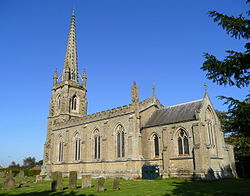Sausthorpe
| Sausthorpe | |
| Lincolnshire | |
|---|---|
 Church of St Andrew, Sausthorpe | |
| Location | |
| Grid reference: | TF383694 |
| Location: | 53°12’11"N, -0°4’12"E |
| Data | |
| Population: | 305 (2011, with Aswardby , Dalby and Langton by Spilsby) |
| Post town: | Spilsby |
| Postcode: | PE23 |
| Local Government | |
| Council: | East Lindsey |
| Parliamentary constituency: |
Louth and Horncastle |
Sausthorpe is a small village in Lindsey, the northern part of Lincolnshire, eight miles east of Horncastle and three miles north-west of Spilsby. It is on the southern edge of the Lincolnshire Wolds, in the valley of the River Lymn. Farming remains as the predominant economic activity of the area.
The name 'Sausthorpe' is believed to derive from "Sauthr's thorpe", a farming settlement here in Viking times.
Church
The parish church, St Andrew, was designed by Charles Kirk and built in 1842 on the site of an earlier mediæval church.[1] It is a Grade II listed building.[2] Its construction was sponsored by Rev. Francis A. Swan, lord of the manor and parish rector from 1819 until his death in 1878.
The spire of St Andrew's is a prominent landmark resembling on a smaller scale that of St James Church, Louth, twelve miles to the north.
The parish priest from 1881 to 1892 was Pelham Dale, who was prosecuted and imprisoned for ritualist practices in 1876 and 1880 (and so regarded as a martyr by Anglo-Catholics). His grave lies under the trees on the eastern side of the churchyard. Inside the church, several Dymoke family gravestones date from the 18th century, having been transferred from the earlier church.
History
In 1885 Kelly's Directory recorded Rev. Charles Trollope Swan LLB as living at Sausthorpe Hall, a "modern mansion in a park of 30 acres". He had inherited the roles of Lord of the Manor and Rector from his father, Francis Swan, in 1878. He granted the rectorate, including the rectory living, residence (the Old Hall) and 34 acres of glebe land, to T. Pelham Dale in 1882.
Rev. Francis A. Swan built a National School for 50 children in 1860. It survived until 1983.
The parish of Sausthorpe had a population of 206 in 30 inhabited houses in 1831.[3]
Kelly's Directory recorded that in 1885 the area of the parish was 727 acres, in which were grown wheat, barley and turnips, that Sausthorpe's population at the time of the 1881 census was 141, and that within the parish were a grocer, wheelwright, carrier, two farmers, a farmer-cum-beer retailer, and a farmer-surveyor.[4]
About he village
Sausthorpe Hall is a late 18th-century Grade II listed country house, extended and remodelled in 1822.[5]
The Old Hall is a Grade II* listed 15th-century house, with 16th and 18th-century alterations. It has rendering over red brick and the remains of a timber frame.[6]
Historically there were three principal farms in the village: East Farm (the farmhouse is set back from the main road about one mile east of the village); Grange Farm (the farmhouse is on the main road at the eastern entry to the village); and Church Farm (the farmhouse, now known as Linden House, is on the corner of the crossroads at the centre of the village).
Outside links
| ("Wikimedia Commons" has material about Sausthorpe) |
References
- ↑ &resourceID=2 National Monuments Record: No. 1034892 – St Andrews, Sausthorpe
- ↑ National Heritage List 1063638: St Andrews, Sausthorpe (Grade II listing)
- ↑ Google Books. Retrieved 30 December 2019.
- ↑ Kelly's Directory of Lincolnshire with the port of Hull 1885, p. 611.
- ↑ National Heritage List 1063637: Sausthorpe Hall (Grade II listing)
- ↑ National Heritage List 1063639: The Old Hall, Sausthorpe (Grade II* listing)
